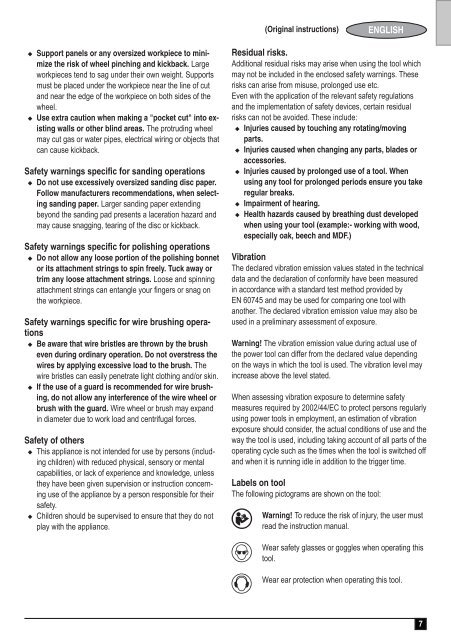BlackandDecker Meuleuse Petit Diamètre- Kg701 - Type 1 - Instruction Manual (Européen)
BlackandDecker Meuleuse Petit Diamètre- Kg701 - Type 1 - Instruction Manual (Européen)
BlackandDecker Meuleuse Petit Diamètre- Kg701 - Type 1 - Instruction Manual (Européen)
Create successful ePaper yourself
Turn your PDF publications into a flip-book with our unique Google optimized e-Paper software.
(Original instructions)<br />
ENGLISH<br />
u Support panels or any oversized workpiece to minimize<br />
the risk of wheel pinching and kickback. Large<br />
workpieces t<strong>en</strong>d to sag under their own weight. Supports<br />
must be placed under the workpiece near the line of cut<br />
and near the edge of the workpiece on both sides of the<br />
wheel.<br />
u Use extra caution wh<strong>en</strong> making a "pocket cut" into existing<br />
walls or other blind areas. The protruding wheel<br />
may cut gas or water pipes, electrical wiring or objects that<br />
can cause kickback.<br />
Safety warnings specific for sanding operations<br />
u Do not use excessively oversized sanding disc paper.<br />
Follow manufacturers recomm<strong>en</strong>dations, wh<strong>en</strong> selecting<br />
sanding paper. Larger sanding paper ext<strong>en</strong>ding<br />
beyond the sanding pad pres<strong>en</strong>ts a laceration hazard and<br />
may cause snagging, tearing of the disc or kickback.<br />
Safety warnings specific for polishing operations<br />
u Do not allow any loose portion of the polishing bonnet<br />
or its attachm<strong>en</strong>t strings to spin freely. Tuck away or<br />
trim any loose attachm<strong>en</strong>t strings. Loose and spinning<br />
attachm<strong>en</strong>t strings can <strong>en</strong>tangle your fingers or snag on<br />
the workpiece.<br />
Safety warnings specific for wire brushing operations<br />
u Be aware that wire bristles are thrown by the brush<br />
ev<strong>en</strong> during ordinary operation. Do not overs<strong>tre</strong>ss the<br />
wires by applying excessive load to the brush. The<br />
wire bristles can easily p<strong>en</strong>etrate light clothing and/or skin.<br />
u If the use of a guard is recomm<strong>en</strong>ded for wire brushing,<br />
do not allow any interfer<strong>en</strong>ce of the wire wheel or<br />
brush with the guard. Wire wheel or brush may expand<br />
in diameter due to work load and c<strong>en</strong>trifugal forces.<br />
Safety of others<br />
u This appliance is not int<strong>en</strong>ded for use by persons (including<br />
childr<strong>en</strong>) with reduced physical, s<strong>en</strong>sory or m<strong>en</strong>tal<br />
capabilities, or lack of experi<strong>en</strong>ce and knowledge, unless<br />
they have be<strong>en</strong> giv<strong>en</strong> supervision or instruction concerning<br />
use of the appliance by a person responsible for their<br />
safety.<br />
u Childr<strong>en</strong> should be supervised to <strong>en</strong>sure that they do not<br />
play with the appliance.<br />
Residual risks.<br />
Additional residual risks may arise wh<strong>en</strong> using the tool which<br />
may not be included in the <strong>en</strong>closed safety warnings. These<br />
risks can arise from misuse, prolonged use etc.<br />
Ev<strong>en</strong> with the application of the relevant safety regulations<br />
and the implem<strong>en</strong>tation of safety devices, certain residual<br />
risks can not be avoided. These include:<br />
u Injuries caused by touching any rotating/moving<br />
parts.<br />
u Injuries caused wh<strong>en</strong> changing any parts, blades or<br />
accessories.<br />
u Injuries caused by prolonged use of a tool. Wh<strong>en</strong><br />
using any tool for prolonged periods <strong>en</strong>sure you take<br />
regular breaks.<br />
u Impairm<strong>en</strong>t of hearing.<br />
u Health hazards caused by breathing dust developed<br />
wh<strong>en</strong> using your tool (example:- working with wood,<br />
especially oak, beech and MDF.)<br />
Vibration<br />
The declared vibration emission values stated in the technical<br />
data and the declaration of conformity have be<strong>en</strong> measured<br />
in accordance with a standard test method provided by<br />
EN 60745 and may be used for comparing one tool with<br />
another. The declared vibration emission value may also be<br />
used in a preliminary assessm<strong>en</strong>t of exposure.<br />
Warning! The vibration emission value during actual use of<br />
the power tool can differ from the declared value dep<strong>en</strong>ding<br />
on the ways in which the tool is used. The vibration level may<br />
increase above the level stated.<br />
Wh<strong>en</strong> assessing vibration exposure to determine safety<br />
measures required by 2002/44/EC to protect persons regularly<br />
using power tools in employm<strong>en</strong>t, an estimation of vibration<br />
exposure should consider, the actual conditions of use and the<br />
way the tool is used, including taking account of all parts of the<br />
operating cycle such as the times wh<strong>en</strong> the tool is switched off<br />
and wh<strong>en</strong> it is running idle in addition to the trigger time.<br />
Labels on tool<br />
The following pictograms are shown on the tool:<br />
:<br />
O<br />
N<br />
Warning! To reduce the risk of injury, the user must<br />
read the instruction manual.<br />
Wear safety glasses or goggles wh<strong>en</strong> operating this<br />
tool.<br />
Wear ear protection wh<strong>en</strong> operating this tool.<br />
7
















